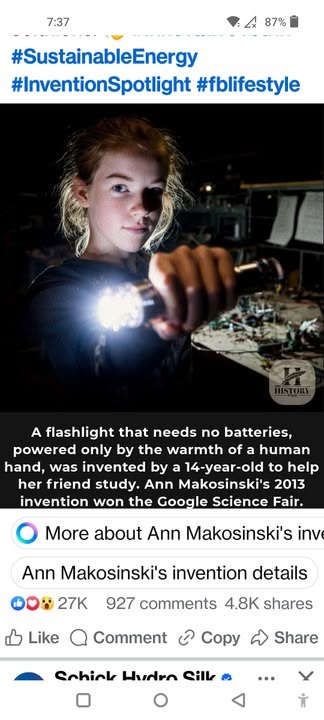It's been 13 years I've never seen one
At just 14 years old, Ann Makosinski harnessed the warmth of her own hand to create a flashlight that needs no batteries. 💡
Her inspiration came from a friend in the Philippines who told her she couldn't study at night and was failing in school because her family had no electricity for light.
Ann wanted to find a way to help. She knew she could capture energy from many sources, including the heat from a human body.
She looked into Peltier tiles, which produce an electric charge when one side of the tile is heated and the other is cooled.
Ann realized that the heat from a person's hand on one side, and the ambient air cooling the other, could generate enough power for an LED light.
Using this principle, she designed the Hollow Flashlight. The design allows air to flow through the device, keeping the outside cool while the inside is warmed by the user's hand.
In 2013, at age 15, her invention won her top prize for her age group at the Google Science Fair.
Her simple, yet brilliant, device showed a new path for sustainable, off-grid energy solutions. 👋 #InnovativeYouth #SustainableEnergy #InventionSpotlight #fblifestyle
Her inspiration came from a friend in the Philippines who told her she couldn't study at night and was failing in school because her family had no electricity for light.
Ann wanted to find a way to help. She knew she could capture energy from many sources, including the heat from a human body.
She looked into Peltier tiles, which produce an electric charge when one side of the tile is heated and the other is cooled.
Ann realized that the heat from a person's hand on one side, and the ambient air cooling the other, could generate enough power for an LED light.
Using this principle, she designed the Hollow Flashlight. The design allows air to flow through the device, keeping the outside cool while the inside is warmed by the user's hand.
In 2013, at age 15, her invention won her top prize for her age group at the Google Science Fair.
Her simple, yet brilliant, device showed a new path for sustainable, off-grid energy solutions. 👋 #InnovativeYouth #SustainableEnergy #InventionSpotlight #fblifestyle







